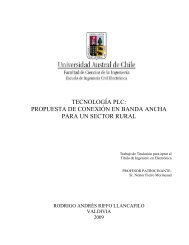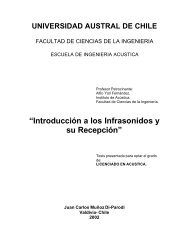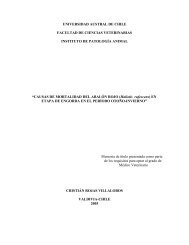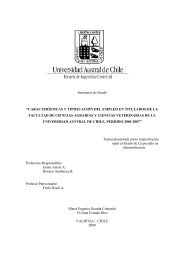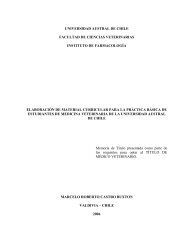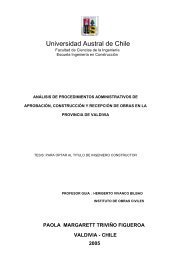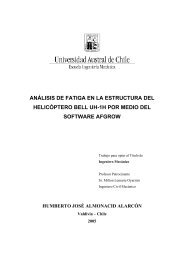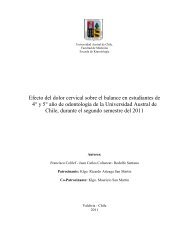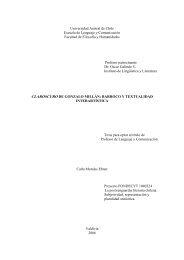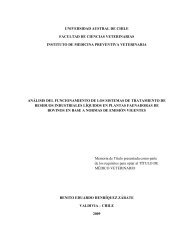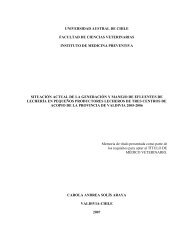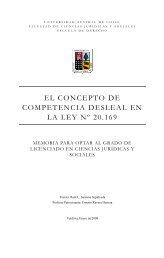Diversidad y control biológico de insectos - CyberTesis UACh ...
Diversidad y control biológico de insectos - CyberTesis UACh ...
Diversidad y control biológico de insectos - CyberTesis UACh ...
You also want an ePaper? Increase the reach of your titles
YUMPU automatically turns print PDFs into web optimized ePapers that Google loves.
Introduction.<br />
Declining diversity has raised concerns for continued provision of ecosystem services (e.g.<br />
natural pest <strong>control</strong>). Intensification of agriculture and the subsequent simplification of<br />
agroecosystems has often reduced biodiversity and can result in pest outbreaks (Swift et al.,<br />
1996). Conservation of both natural enemies and non-target herbivores is <strong>de</strong>sirable because<br />
they play an essential role in whole community dynamics, and within the bio<strong>control</strong><br />
context, they may act as useful predators or as alternative prey when the target species is<br />
scarce (Kenmore et al., 1984; Hardin et al., 1995)<br />
Dalaca pallens (Blanchard 1852) (Lepidoptera: Hepialidae) is a native moth from South<br />
America (Chile and Argentina) and the most important grassland pest in Southern Chile.<br />
Adults emerge in late spring and drop eggs over pastures in flight. The larvae burrow a<br />
vertical gallery in the soil and hi<strong>de</strong> in it during daylight. At night, the larvae move to the<br />
soil surface consuming leaves and culms. The larval stages <strong>de</strong>velop over 6-8 months in soil,<br />
causing extensive loss of forage during this time. About 10% of grassland area (ca.<br />
200,000-300,000 ha) is sprayed against this insect every year, using conventional<br />
insectici<strong>de</strong>s such as insect growth regulators and pyrethroids. However, their use is seen as<br />
un<strong>de</strong>sirable for biological and economic reasons, therefore alternative strategies are nee<strong>de</strong>d<br />
to manage this insect and reduce the reliance on chemical insectici<strong>de</strong>s.<br />
Beauveria bassiana Balsamo (Vuillemin) is un<strong>de</strong>r study as an efficient, environmentally-<br />
friendly and economically competitive biopestici<strong>de</strong> for D. pallens <strong>control</strong> in Chile. One<br />
potentially useful strain has been selected after conducting in vitro mortality assays and<br />
field studies, which showed that the fungus caused mortality rates similar to the insectici<strong>de</strong><br />
cyhalothrin-lambda, when sprayed at 10 12 spores per ha (Cisternas et al., 2003). Farmers<br />
have begun to adopt this new technology and the sprayed area increased from 20 ha in 2003<br />
to 300 ha in 2005. However, effects on non-target invertebrates are unknown, as is this<br />
treatment’s potential conflict with other biological <strong>control</strong> agents. Several studies have<br />
reported si<strong>de</strong> effects of Beauveria spp. on non-target arthropods, including carabid larvae<br />
(Traugott et al., 2000), braconid and encyrtid wasps (Danfa and van <strong>de</strong>r Valk, 1999) and<br />
coccinellid predators (Jayanthi and Padmavathamma, 1996). Preliminary assays on the<br />
Chilean species Allendia chilensis (Col.: Carabidae) and Phytoloema herrmanni (Col.:<br />
104



